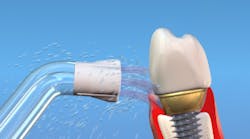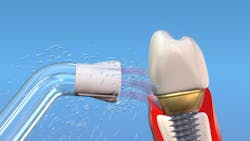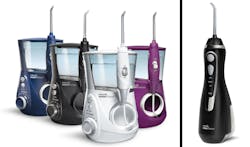The dental implant has become a mainstay for the successful restoration of missing teeth. Yet people with dental implants are at risk for developing peri-implant mucositis. When caught early and treated nonsurgically, mucositis can be reversed. If not, it can lead to peri-implantitis or bone loss around the implant. Peri-implantitis increases the risk for implant failure. (1)
Peri-implant mucositis is common, occurring in up to 80% of people with implants or about 50% of implant sites. (2) The most common cause is the buildup of bacterial biofilm. The same type of gram-negative anaerobic bacteria present in periodontal disease is often found in peri-implant diseases. Therefore, the daily elimination of bacterial biofilm is a key strategy in treating perimucositis. (1)
Self-care may be challenging for people with implants. Whether due to positioning or design, the use of dental floss may not be possible for some people with implants. One self-care device that has been tested and found safe and effective around implants is the Waterpik Water Flosser used with the Plaque Seeker tip. In a study conducted at Tufts University in Boston, people who used the Water Flosser with the Plaque Seeker tip reduced bleeding around implants twice as much as people who used string floss. (3) Specifically, the results found that 19 of 22 implants (81.8%) treated with the Plaque Seeker had a significant reduction in bleeding compared to 6 of 18 (33.3%) implants that were treated with string floss. (3)
The pulsating action of the Water Flosser helps patients safely and effectively clean difficult-to-access areas, such as those surrounding implants. The combination of pulsation and pressure produces shear hydraulic forces that are capable of biofilm removal. (4) Research indicates that the Water Flosser can disrupt periodontal pathogens in pockets up to 6 mm deep. (5) A safety review of the literature concluded that the Water Flosser does not push bacteria into the pocket, increase probing depth, or traumatize soft tissue. Additionally, the Water Flosser does not produce a higher rate of bacteremia than brushing or flossing. (6)
The Plaque Seeker tip is a modification of the Classic Jet tip that features three thin tufts of bristles to help access and remove biofilm (figure 1). The tip is easy to use because the filaments can be traced along the gingival margin and embrasure area, which can be especially beneficial to first-time users. New users tend to look in the mirror when using the Water Flosser, which can result in water splashing on the counter or the person. To avoid this, advise patients to look into the sink. The tip should be used on both the facial and lingual areas.
It’s important to instruct new users to begin using the Water Flosser on the lowest pressure setting and increase the pressure setting as it becomes comfortable. The Water Flosser has been shown to be most effective on the medium-high setting. This means patients should reach at least the "7" setting on a countertop (figure 2) or the high setting on a Cordless unit (figure 3), as this was the pressure found effective for implants in the study conducted with the Plaque Seeker tip. (3)
Regarding what solutions are best for the Water Flosser, tap water has been evaluated and found effective in numerous Water Flosser studies, including the implant study at Tufts. (3) Warm or room temperature water is recommended. Medicaments may also be used. Many people like to add a capful of their favorite mouthwash to the water solution. Any time an agent other than water is used in the Water Flosser, it is recommended to partially fill the reservoir with water and flush the unit.
Thorough daily biofilm removal is important in preventing peri-implant mucositis. The Waterpik Water Flosser used with the Plaque Seeker tip can help patients achieve and maintain good implant health.
Editor's note: This article first appeared in Pearls for Your Practice: The Product Navigator. Click here to subscribe. Click here to submit a products article for consideration.
References
1. American Academy of Periodontology. Peri-implant mucositis and peri-implantitis: a current understanding of their diagnoses and clinical implications. J Periodontol. 2013;84(4):436-443.
2. Lindhe J, Meyle J; Group D of European Workshop on Periodontology. Peri-implant diseases: Consensus Report of the Sixth European Workshop on Periodontology. J Clin Periodontol. 2008;35(8 Suppl.):282-285
3. Magnuson B, Harsono M, Stark PC, Lyle D, Kugel G, Perry R. Comparison of the effect of two interdental cleaning devices around implants on the reduction of bleeding: A 30-day randomized clinical trial. Compend Contin EducDent. 2013;34(Spec. No. 8):2-7.
4. Gorur A, Lyle DM, Schaudinn C, Costerton JW. Biofilm removal with a dental water jet. Compend Contin Educ Dent. 2009;30(Spec. No. 1):1-6.
5. Cobb CM, Rodgers RL, Killoy WJ. Ultrastructural examination of human periodontal pockets following the use of an oral irrigation device in vivo. J Periodontol. 1988;59(3):155-163.
6. Jolkovsky DL, Lyle DM. Safety of a water flosser: A literature review. Compend Contin Educ Dent. 2015;36(2):146-149.










